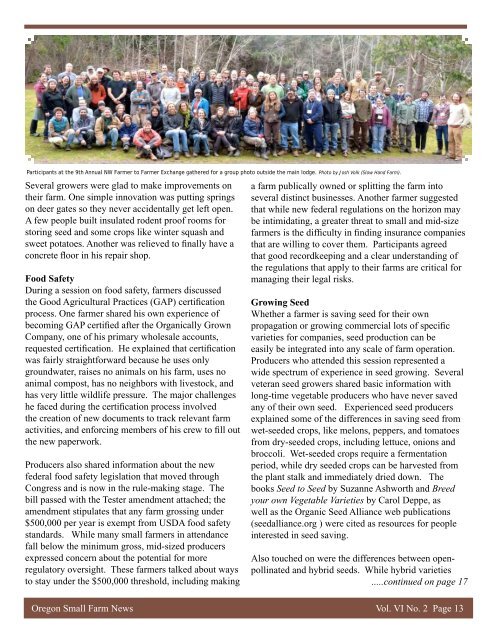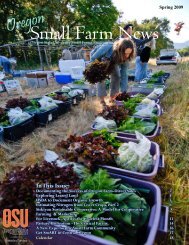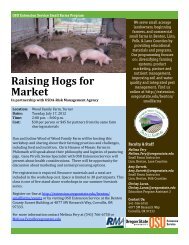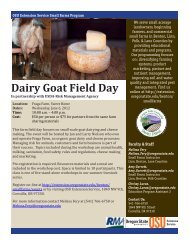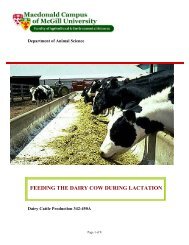Small Farm News - Oregon Small Farms - Oregon State University
Small Farm News - Oregon Small Farms - Oregon State University
Small Farm News - Oregon Small Farms - Oregon State University
Create successful ePaper yourself
Turn your PDF publications into a flip-book with our unique Google optimized e-Paper software.
Participants at the 9th Annual NW <strong>Farm</strong>er to <strong>Farm</strong>er Exchange gathered for a group photo outside the main lodge. Photo by Josh Volk (Slow Hand <strong>Farm</strong>).Several growers were glad to make improvements ontheir farm. One simple innovation was putting springson deer gates so they never accidentally get left open.A few people built insulated rodent proof rooms forstoring seed and some crops like winter squash andsweet potatoes. Another was relieved to finally have aconcrete floor in his repair shop.Food SafetyDuring a session on food safety, farmers discussedthe Good Agricultural Practices (GAP) certificationprocess. One farmer shared his own experience ofbecoming GAP certified after the Organically GrownCompany, one of his primary wholesale accounts,requested certification. He explained that certificationwas fairly straightforward because he uses onlygroundwater, raises no animals on his farm, uses noanimal compost, has no neighbors with livestock, andhas very little wildlife pressure. The major challengeshe faced during the certification process involvedthe creation of new documents to track relevant farmactivities, and enforcing members of his crew to fill outthe new paperwork.Producers also shared information about the newfederal food safety legislation that moved throughCongress and is now in the rule-making stage. Thebill passed with the Tester amendment attached; theamendment stipulates that any farm grossing under$500,000 per year is exempt from USDA food safetystandards. While many small farmers in attendancefall below the minimum gross, mid-sized producersexpressed concern about the potential for moreregulatory oversight. These farmers talked about waysto stay under the $500,000 threshold, including makinga farm publically owned or splitting the farm intoseveral distinct businesses. Another farmer suggestedthat while new federal regulations on the horizon maybe intimidating, a greater threat to small and mid-sizefarmers is the difficulty in finding insurance companiesthat are willing to cover them. Participants agreedthat good recordkeeping and a clear understanding ofthe regulations that apply to their farms are critical formanaging their legal risks.Growing SeedWhether a farmer is saving seed for their ownpropagation or growing commercial lots of specificvarieties for companies, seed production can beeasily be integrated into any scale of farm operation.Producers who attended this session represented awide spectrum of experience in seed growing. Severalveteran seed growers shared basic information withlong-time vegetable producers who have never savedany of their own seed. Experienced seed producersexplained some of the differences in saving seed fromwet-seeded crops, like melons, peppers, and tomatoesfrom dry-seeded crops, including lettuce, onions andbroccoli. Wet-seeded crops require a fermentationperiod, while dry seeded crops can be harvested fromthe plant stalk and immediately dried down. Thebooks Seed to Seed by Suzanne Ashworth and Breedyour own Vegetable Varieties by Carol Deppe, aswell as the Organic Seed Alliance web publications(seedalliance.org ) were cited as resources for peopleinterested in seed saving.Also touched on were the differences between openpollinatedand hybrid seeds. While hybrid varieties.....continued on page 17<strong>Oregon</strong> <strong>Small</strong> <strong>Farm</strong> <strong>News</strong> Vol. VI No. 2 Page 13


